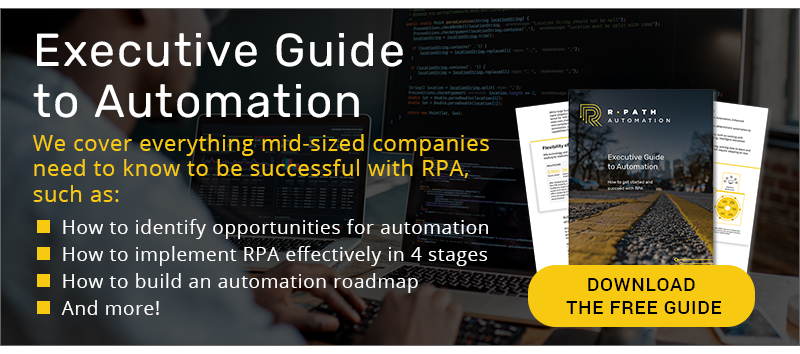The benefits of Robotic Process Automation (RPA) are attractive to businesses looking to increase efficiency, boost output, and/or streamline workflows. However, many organizations are uncertain whether it’s better to upgrade legacy systems or employ automation technologies like RPA to maintain their competitive edge. The truth is, RPA often helps organizations get improved business results from their legacy systems.
Replacing or updating older software platforms seems logical, but organizations that pursue that option often discover the proverbial devil in the details. Long-used legacy systems – in healthcare, financial services, public infrastructure, or elsewhere – are likely still in use because they play a key role in mission-critical operations.
The capabilities (or sometimes, limitations) of these aging platforms dictate the workflows that employees must engage each day, and as a result, there’s seldom an opportunity to innovate a process or even integrate with a new system. Hence, to make changes to key, back-end systems requires an organization to also commit to overhauling one or more core processes.
Thankfully, RPA offers an efficient and cost-effective solution for organizations bound to outdated systems. It acts as a bridge to connect legacy systems to new ones or to create simpler, more efficient processes on existing systems. In short, RPA saves you the time, money, and headaches that come with significant system upgrades.

4 Key Benefits of RPA
Why do organizations rely on RPA to enhance existing systems? Every implementation is unique, but here are a few common reasons why organizations might choose to deploy automation rather than upgrade their legacy software:
1. Cost Savings
Purchasing and implementing new systems is expensive. Hardware, software, user training, and support costs add up quickly and may be difficult to justify based on the quantifiable returns. RPA implementations, on the other hand, require minimal infrastructure changes, fewer human resources to manage, and significantly lower labor costs compared to deploying an entirely new system.
2. Shorter Implementation Times
System upgrades always take longer than expected. Design flaws, missed steps, and compatibility issues inevitably lead to distracted, frustrated teams who become reluctant to embrace change.
Robotic Process Automation is a non-intrusive solution that does not require integrations, complex application programming interfaces (APIs), or lengthy development. RPA can be swiftly deployed on top of your existing infrastructure to add functionality without causing disruptions. Deployments are often measured in weeks rather than months.
3. Reduced Employee Workloads
One of the most significant benefits of RPA is that there are no new systems for your team to learn and spend time transitioning to. Instead, they simply hand over their most mundane, tedious work to RPA’s digital workers.
These workers emulate the manual steps employees already perform on legacy systems, albeit much faster and more accurately than their human counterparts. In turn, employees can focus on more meaningful tasks that are better aligned with their skills and provide increased value to the organization.
4. Improved Future Readiness
Clearly, RPA can help organizations get a lot more mileage out of their existing systems. That said, if the need should ultimately arise to upgrade legacy software, or if you need to introduce a new system that doesn’t have a native integration option, automation can make the process more manageable. Digital workers can process and transfer data from existing systems to new ones much faster than using manual techniques alone.

RPA Compliments Legacy System Capabilities
Even after learning about the advantages of pairing RPA and legacy systems, some may still wonder if it’s the right option. If that’s you, consider these more strategic observations:
- By automating processes built on a legacy system, you unchain the employee from the platform. Your people are no longer the ones stringing parts of a limited system together, scanning for errors, creating stopgaps, and porting data from one application to another.
- With RPA, digital employees are assigned to the repetitive transactions that most humans don’t want to deal with anyway. Automation handles all the copying and pasting, counting and sorting, data processing, and more that you can throw at it, 24/7/365.
- Simply stated, rather than being bound to the limitations of legacy systems, RPA helps free employees from them.
- RPA allows organizations to leave legacy systems in place while streamlining existing, or creating new, processes. For example, a Customer Success team might have an aging CRM system “that works,” but it doesn’t provide the needed flexibility for updating input forms to receive critical information for the Finance team. In such cases, RPA could be used to assimilate disparate data sources on the front-end without affecting core, back-end processes.
- By pairing automation with existing systems that continue to run well, organizations can avoid an intense change management project but still improve services for both their customers and employees.
Is RPA an Ideal Solution?
In the end, RPA cannot replace outdated systems, but it can be used to extend capabilities and/or improve the efficiency of existing processes. Automation improves the operational life of legacy software and helps organizations to avoid costly upgrades, training costs, and the dismantling of tightly integrated workflows. The benefits of RPA can be real solutions to a universal problem that becomes more apparent every year.
Interested in learning how to get started and succeed with RPA in your organization?
Be sure to check out our free Executive Guide to Automation. This valuable resource will help you identify, implement, and evaluate automation opportunities within your environment.

